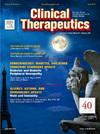从马来西亚公共医疗系统的角度分析达帕格列净治疗射血分数降低型心力衰竭患者的预算影响
IF 3.2
4区 医学
Q2 PHARMACOLOGY & PHARMACY
引用次数: 0
摘要
这是一项预算影响分析,从马来西亚卫生部(MOH)的角度出发,比较了使用达帕格列净加标准护理(SoC)治疗射血分数降低型心力衰竭(HFrEF)与不使用达帕格列净治疗的方案,时间跨度为 5 年。为进行这种比较,我们开发了一个基于 Microsoft Excel 的成本计算器。符合条件人群的估计规模、达帕格列净的服用率以及与药物、临床事件和不良事件相关的成本均基于已公布的数据、官方关税和数据库以及专家意见。DAPA-HF试验的临床数据被用于疗效和安全性输入(即心力衰竭住院(hHF)、心血管死亡和不良事件)。结果以年度和累计总成本(以 2023 年马来西亚林吉特、美元和欧盟欧元计算;汇率为 1 美元 = 4.40 林吉特和 1 欧元 = 4.90 林吉特)以及临床事件数量进行报告。此外,还进行了敏感性分析和情景分析。基本情况分析估计,在五年时间内,采用达帕格列净治疗 HFrEF 将累计节省成本 260 万马币(60 万美元/50 万欧元),成本降低 0.3%,主要是由于减少了对 HHF 的支出。此外,达帕格列净治疗可减少 731 例高血压和 366 例心血管死亡。敏感性分析和情景分析表明,研究结果对襻利尿剂需求和达帕格列净成本的假设最为敏感。虽然预计前四年可节约成本或实现净零结余,但从长远来看,达帕格列净的使用率预计每年增加 2.5%,这将从第五年开始增加卫生部的成本。将达帕格列净纳入 SoC 可以改善 HFrEF 患者的健康状况,并可能节约成本,从而在短期内减轻 HFrEF 管理对马来西亚公共医疗系统造成的经济压力。尽管如此,随着时间的推移,越来越多的患者接受治疗,预计预算会略有增加。本文章由计算机程序翻译,如有差异,请以英文原文为准。
Budget Impact Analysis of Dapagliflozin in Treating Patients With Heart Failure With Reduced Ejection Fraction From the Perspective of Malaysian Public Healthcare System
Purpose
This is a budget impact analysis that compared the scenario of treating heart failure with reduced ejection fraction (HFrEF) using dapagliflozin plus standard of care (SoC) versus a scenario without dapagliflozin, from the perspective of Ministry of Health (MOH) Malaysia over a 5-year time horizon.
Methods
A Microsoft Excel-based cost calculator was developed for such comparison. The estimated size of eligible population, uptake rates for dapagliflozin, as well as costs related to drugs, clinical events, and adverse events were based on published data, official tariffs, and databases, and expert opinion. Clinical data from the DAPA-HF trial were used to inform efficacy and safety inputs (i.e., hospitalization for heart failure (hHF), cardiovascular death, and adverse events). Results were reported as total annual and cumulative costs (in 2023 Malaysian Ringgits [RM], United States Dollars [USD], and European Union Euros, [EUR]; with exchange rates of 1 USD = RM 4.40 and 1 EUR = RM 4.90]), as well as the number of clinical events. Sensitivity and scenario analyses were also conducted.
Findings
The base-case analysis estimated that over a five-year period, the adoption of dapagliflozin for HFrEF treatment would result in a cumulative cost-saving of RM 2.6 million (USD 0.6 million/EUR 0.5 million), representing a 0.3% reduction in costs, driven primarily by reduced expenditure on hHF. Moreover, dapagliflozin treatment would lead to 731 fewer hHF and 366 fewer cardiovascular deaths. Sensitivity and scenario analyses revealed that the results were most sensitive to assumptions regarding loop diuretic requirements and the cost of dapagliflozin. Although cost savings or a net-zero balance were projected for the first four years, an anticipated 2.5% annual increase in dapagliflozin uptake in the longer term would lead to additional costs for the MOH, starting from the fifth year.
Implications
Incorporating dapagliflozin into the SoC can improve health outcomes for HFrEF patients and may generate cost savings, potentially easing the economic strain of HFrEF management on Malaysia's public healthcare system in the short term. Nonetheless, a modest increase in budget should be anticipated as more patients gain access to the treatment over time.
求助全文
通过发布文献求助,成功后即可免费获取论文全文。
去求助
来源期刊

Clinical therapeutics
医学-药学
CiteScore
6.00
自引率
3.10%
发文量
154
审稿时长
9 weeks
期刊介绍:
Clinical Therapeutics provides peer-reviewed, rapid publication of recent developments in drug and other therapies as well as in diagnostics, pharmacoeconomics, health policy, treatment outcomes, and innovations in drug and biologics research. In addition Clinical Therapeutics features updates on specific topics collated by expert Topic Editors. Clinical Therapeutics is read by a large international audience of scientists and clinicians in a variety of research, academic, and clinical practice settings. Articles are indexed by all major biomedical abstracting databases.
 求助内容:
求助内容: 应助结果提醒方式:
应助结果提醒方式:


